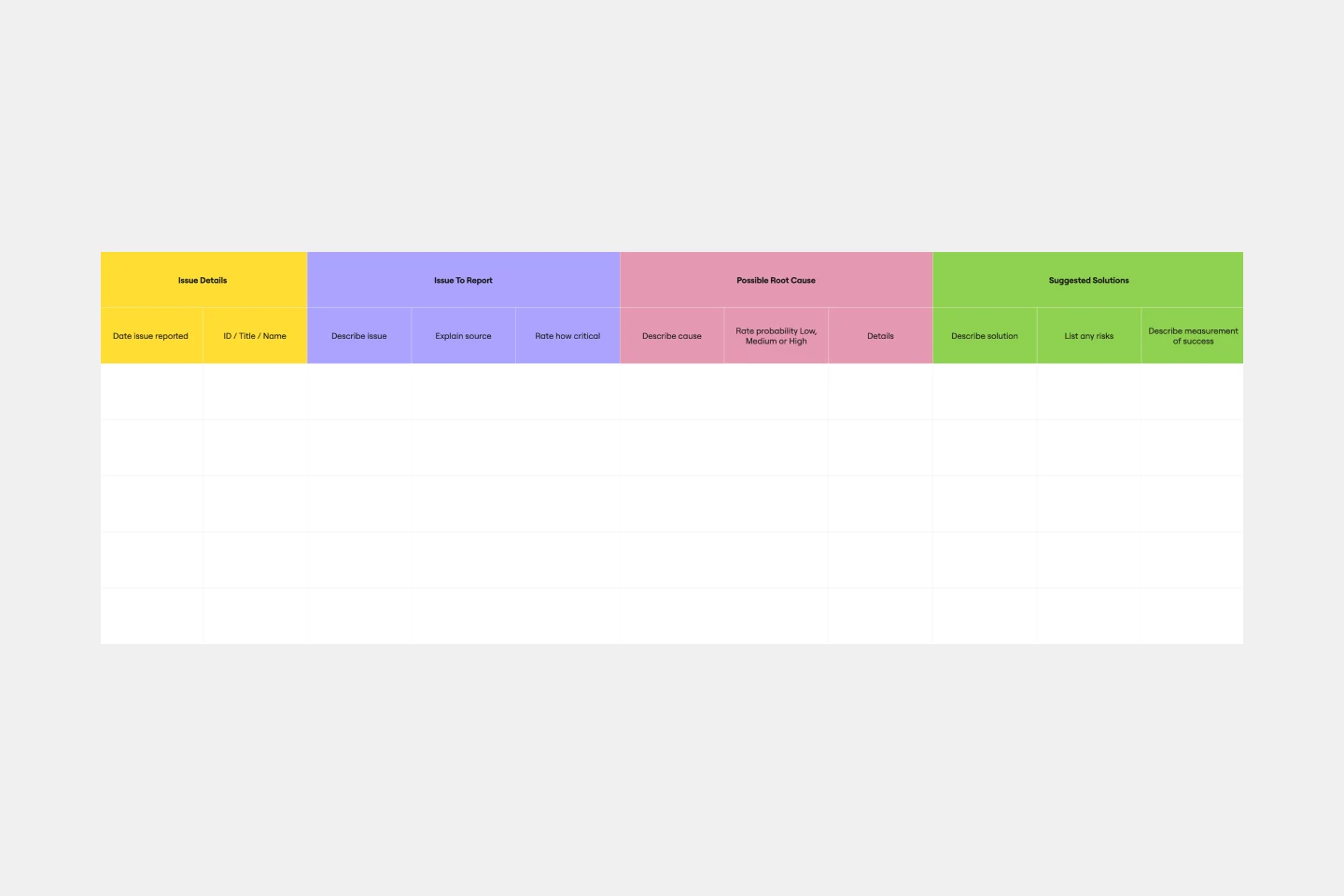Root cause analysis templates
Miro's root cause analysis templates empower you to uncover the underlying causes of problems with ease. Whether you're troubleshooting, improving processes, or preventing future issues, these templates provide a structured approach to identify patterns, visualize causes, and drive actionable solutions.
Root Cause Analysis (RCA) Template
Works best for:
Strategy, Planning
The Root Cause Analysis (RCA) Template is a structured tool that helps teams uncover the underlying reasons behind specific problems or events. By pinpointing and addressing these root causes, rather than just treating the symptoms, organizations can foster long-term solutions and prevent recurring challenges, leading to more efficient and sustainable operations.
Fishbone Diagram Template
Works best for:
Operations, Diagrams, Workflows
What is the best way to solve any problem your team faces? Go straight to the root. That means identifying the root causes of the problem, and fishbone diagrams are designed to help you do it best. Also known as the Ishikawa Diagram (named after Japanese quality control expert Kaoru Ishikawa), fishbone diagrams allow teams to visualize all possible causes of a problem, to explore and understand how they fit together holistically. Teams can also use fishbone diagrams as a starting point for thinking about what the root cause of a future problem might be.
Fishbone Diagram for Root Cause Analysis Template
Works best for:
Fishbone Diagram
The Fishbone Diagram for Root Cause Analysis template helps identify and analyze the underlying causes of a problem. It visually breaks down issues into categories, such as people, processes, and equipment, to uncover root causes. Perfect for teams aiming to solve problems systematically, enhance processes, and prevent future occurrences. Ideal for brainstorming and collaborative analysis sessions.
Root Cause Evaluation Template
When you first encounter a complex situation, it's not common to immediately delve into its underlying causes and effects. Often, we grasp the overall picture but fail to separate the problem from its surrounding circumstances. Root Cause Evaluation provides a method to better understand the interconnected factors that have contributed to the current situation.
Cause and Effect Diagram Template
Works best for:
Diagramming
The Cause and Effect Diagram Template is a useful tool for analyzing complex relationships, identifying root causes of problems, and improving organizational processes. It can be customized to fit user's unique needs and provides a structured framework for analysis. Teams can use real-time collaborative analysis on the Miro platform to drive continuous improvement initiatives.
Fishbone RCA
Works best for:
Problem solving, Strategy
Use the Fishbone RCA template to conduct a thorough root cause analysis (RCA) for any problem. This template helps you break down complex issues into manageable categories, enabling you to identify the underlying causes. It's an effective tool for improving processes, solving problems, and preventing future issues.
Join thousands of teams collaborating and doing their best work on Miro.
Sign up freeAbout the Root Cause Analysis Templates Collection
Root cause analysis (RCA) templates in Miro are designed to help teams identify, analyze, and solve problems at their source. These templates provide a structured approach to uncovering the underlying causes of issues, ensuring that solutions are effective and long-lasting. Whether you're dealing with a recurring problem or a one-time incident, Miro's root cause analysis templates can guide you through the process, making it easier to collaborate and communicate with your team.
Why you'll love our root cause analysis templates
Using Miro's root cause analysis templates offers many benefits that can significantly improve your problem-solving efforts:
Structured approach: The root cause analysis template provides a clear, step-by-step framework that helps teams systematically identify the root causes of problems.
Collaboration: Miro's online workspace allows team members to collaborate in real-time, regardless of their location, making it easier to gather diverse perspectives and insights.
Visualization: The templates' visual nature helps teams better understand complex issues and the relationships between different factors.
Efficiency: By using a pre-designed template, teams can save time and focus on the analysis rather than on creating the structure from scratch.
Documentation: The templates help in documenting the entire analysis process, which can be useful for future reference and for sharing with stakeholders.
Flexibility: Miro's templates are customizable, allowing teams to adapt them to their specific needs and processes.
How to use the root cause analysis templates in Miro
Using Miro's free root cause analysis template is straightforward and can be broken down into a few simple steps:
Select a template: Start by choosing a root cause analysis template from Miro's template library. You can find templates for various RCA methods, such as the Fishbone Diagram, 5 Whys, and more.
Define the problem: Clearly state the problem you are trying to solve. This will be the starting point for your analysis.
Gather data: Collect relevant data and information about the problem. This can include observations, reports, and input from team members.
Identify possible causes: Use the template to brainstorm and list all possible causes of the problem. Encourage team members to think broadly and consider all potential factors.
Analyze causes: Examine each potential cause in detail to determine its likelihood and impact. Use the template's structure to organize your findings and identify the most probable root causes.
Develop solutions: Once the root causes are identified, brainstorm potential solutions. Use the template to document these solutions and plan the steps needed to implement them.
Implement and monitor: Put your solutions into action and monitor their effectiveness. Use the template to track progress and make any necessary adjustments.
By following these steps, teams can effectively use Miro's root cause analysis templates to identify and solve problems, leading to improved processes and outcomes.
